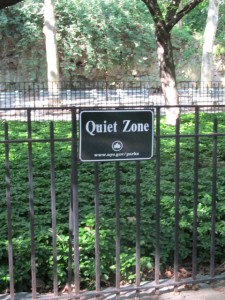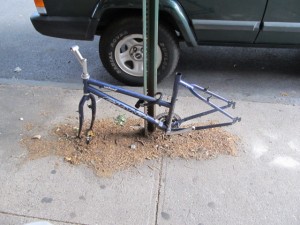June 27, 2011
Monday
[Mr. Head] had been thinking about this trip for several months but it was for the most part in moral terms that he conceived it. It was to be a lesson that the boy would never forget. He was to find out from it that he had no cause for pride merely because he had been born in a city. He was to find out that the city is not a great place. Mr. Head meant him to see everything there is to see in a city so that he would be content to stay at home for the rest of his life.
       — Flannery O’Connor, 1925-1964
American fiction writer
from “The Artificial Nigger”
My Aunt Mary, my mother’s older sister, was born in 1908 and attended Temple University in Philadelphia in the late 1920s. So did my mother, very briefly. Unable to overcome her shyness and her homesickness (she was barely 16), she left before midterms in her first semester. The daughters of a mail carrier, they had grown up in a small town in Pennsylvania’s coal country, encouraged by their parents to get the advanced education that had been impossible for earlier generations. In the short time that Mary and Rose were coeds together in the big city, they stayed in a rooming house occupied by other young women students.
My mother sometimes told a story about something that happened that fall on a football Saturday. This was in the beginning of Temple’s era as a football power, the era when game attendance was a must for the socially conscious individual. Both sisters had gone to the game, and when they returned to their rooming house, my Aunt Mary, in her youthful joy, exclaimed, “We won!”
An older girl, full of acquired sophistication and a sense of superiority, looked up from her book and said, in a tone that withered both of the Dwyer sisters, “Well did we now.”
I have remembered that story for years. I’ve had that experience, of course, expressing myself about a new discovery or an unexpected, unfamiliar pleasure, only to be put down by someone probably seeking to elevate herself. I felt it the first time someone made a dismissive remark about my hat.
I’m wearing that hat as I go about the city this month. When it comes to being a tourist, a stranger in a strange land, I make no pretense at sophistication. Very little truly surprises me, causing me to gawk openly. But I like to move through this world with a sense of wonder, an amazement that I am not shy about expressing about the differences between where I come from and where I am.
 I wasted no time on this first full day of a month when I plan to see things I can’t see anywhere else. Just after my morning C&C (the eat and pray portions of the day), I took a walk in Carl Schurz Park, a place I learned about from “Secret Places to Find Solitude in Manhattan,” an article someone posted on Facebook in April that seemed intended just for me.
I wasted no time on this first full day of a month when I plan to see things I can’t see anywhere else. Just after my morning C&C (the eat and pray portions of the day), I took a walk in Carl Schurz Park, a place I learned about from “Secret Places to Find Solitude in Manhattan,” an article someone posted on Facebook in April that seemed intended just for me.
The park is only a few blocks from the apartment where I am staying. I walked one block to York Avenue, passing the ASPCA place on 92nd where the cats were not yet cavorting in the window, although I did watch a young woman exit the building wrestling a large animal carrier (the carrier was large — not sure about the animal inside) to the bus stop at the corner. I will probably always be amazed at the things people manage to transport on the bus and the subway.
Carl Schurz is Central Park in miniature, 15 acres of paved paths that wind through landscaped areas and playgrounds, a basketball court, and a dog park. Gracie Mansion, the official residence of the mayor of New York, is within its boundaries. It has a very definite 19th century feel, and I think it will be the one place on the “secret solitude” list that I will return to often, not only because it’s the one I can walk to.
In the late afternoon I went out to Brooklyn to visit a writer friend who normally lives in western Massachusetts but who is caring for her three-year-old granddaughter this last week in June before the child’s summer camp begins. I am most obviously a tourist when I am on the subway. I watch people find a seat (or not) and then open a thick book, which they begin to read. Presently, without looking up from the book, they close it, stand up, and exit the train. Me? I’m clutching the index card on which I have written the directions I’ve gotten from Hop Stop, counting the stations as I pass them.
Josie and her grandmother were in the middle of an art project when I arrived, the child carefully applying yellow paint to the body of an unfinished matryoshka doll. She reminded me of Lynn at that age, and in the middle of this current solo gallivant that I can undertake because I have no maternal obligations anymore, I missed those vanished days.
When Josie’s mother came home from work, my friend and I walked a few blocks to a quiet Thai restaurant for dinner. Afterward, we took leave of each other at the corner so that my friend could get back for tuck-in time and I could be on my way before full dark. As I walked down the hill toward the subway station, I snapped the picture below. Does the bicycle owner have to reassemble his bike every single time he wants to use it, or has someone made off with both tires and the handlebars? And if he has disassembled it, where has he put all that hardware? If he has room for that, wouldn’t he also be able to take the frame inside as well?
